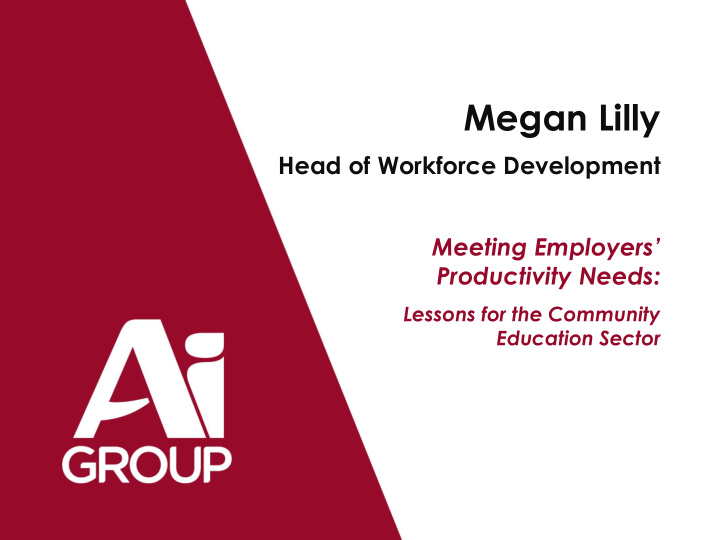



Megan Lilly Head of Workforce Development Meeting Employers’ Productivity Needs: Lessons for the Community Education Sector
Did you know?
Did you know?
Did you know?
Researchers predict that 65% of today’s grade schoolers will hold jobs that don’t yet exist. U.S. Department of Labor estimates today’s learner will have 10 – 14 jobs by the age of 38.
The Changing Economy Key Megatrends Growth in computing power, connectivity, data volumes, artificial intelligence Changing employment markets & organisation structures The era of the entrepreneur Continued growth in services sector
The Changing Economy 44% of jobs at risk of digital disruption 79% of CEOs concerned by impact of changes in core technology
The Emergence of the “Gig Economy”
Entrepreneurialism Rise of new technology and digital disruption affecting workforce Small and agile businesses operated by young entrepreneurs – technology-based
Global Innovation Index
Australia & Global Innovation
Global Competitiveness Index
Global Competitiveness Report Australian Performance Education & Training Innovation
Switzerland & Innovation Australia is lagging in these areas
Occupation and Education
Employment by Occupation: 1993 and 2014
High Skill Occupation Growth
Projected Growth by Industry
Projected Occupational Growth
Fastest Growing Employment 23% growth: Design, engineering, science and transport professionals 19% growth: ICT professionals
International Comparisons STEM jobs in the US are growing 3 times more than non- STEM jobs … … expected to grow twice as fast by 2018
STEM and the Workforce University STEM Qualifications 75% professionals, managers VET STEM Qualifications 41% technicians, trade workers 25% professionals, managers
Prepared Workforce? Australia ranks overall 18 out of 130 countries Ranked 5 th for high tertiary participation in 15 – 24 age group However, skills diversity in the workplace and education is relatively low
STEM and Innovation A STEM education underpins innovation and plays a critical role in economic and business growth. But Australia is lagging on key indicators of STEM. A smart move, PwC
STEM and the Economy STEM skills jobs fastest growing rate in economy 65% of economic growth per capita 18% of workforce have STEM qualifications
Skilling Implications Education and training is becoming more important Higher level skills are becoming more important New capabilities needed for new jobs of future The need for digital literacy Importance of STEM skills
The Way Forward
Industry 4.0 Higher Apprenticeship Program Ai Group, Siemens Ltd and Swinburne University of Technology New qualifications: Diploma and Associated Degree of Applied Technology Delivered in apprenticeship mode Providing a blend of vocational education and higher education New direction for industry and tertiary education in Australia
Recommend
More recommend